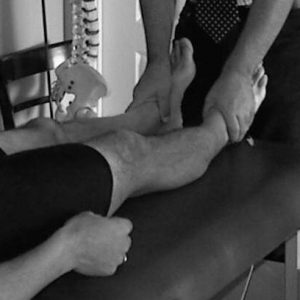A 2003 literature review on the topic of leg length inequality (LLI) or discrepancy (LLD) and LBP concluded that, “…little agreement exists regarding the prevalence of limb length inequality, the degree of limb length inequality that is considered clinically significant, and the reliability and validity of assessment methods” (Brady et al 2003).

An extensive review found that when compared to radiological evaluation, observational

and measuring tape technique lack reliability and validity in detecting LLD (Sabharwal 2008). However, considering the impracticality of having patients receive full lower body x-rays, the following 3 inaccurate observational tests for identifying LLD may be used.
- Iliac crests in standing
- Medial malleoli in supine lying
- Tibial tuberocities in crook lying
Consider leg length inequality or abnormal foot biomechanics as potential contributing physical factor if the patient…
- Reports of LBP primarily with standing and walking
- Presents with obvious LLD of greater than 1cm
- Presents with bilateral or unilateral pes planus
“…there is much disagreement in the literature about the magnitude from which LLD requires treatment.” – D’Amico et al 2022
Although the existence of LLD is not questioned, there is however strong controversy over what constitutes a clinically significant LLD (Brady et al., 2003).
Clinically, a 2cm LLD would be obvious to see and if a patient presented with any knee, hip or LBP related to standing sensitivity, it is suggested to perhaps gradually correct the LLD starting by 50% (Menez et al 2021); for instance with a 10mm shoe insert to begin with.
“The evidence suggests that, for most people, anatomic leg-length inequality does not appear to be clinically significant until the magnitude reaches approximately 20 mm.” – Knuston et al 2005
What about LLD in the pediatric population? If significant (>2cm), then perhaps surgery (Friend 2008). I would argue for mild LLD (<2cm) to leave it alone and allow the child to lead a NORMAL life without correction and allow their body to adapt to their LLD. Having said that, one study has found correcting pronation in children with scoliosis to be of some value.
There is low quality evidence that LLD correction for juvenile scoliosis… “Custom foot orthoses can be considered in the management of mild idiopathic scoliosis in juvenile patients.” – Rothschild et al 2020
If you choose to correct LLD as a trial, I suggest starting with inexpensive inserts that can be purchased from the Dollar store or from Amazon. Some argue that full-length inserts are superior to just heel lifts, but the jury is still out on that debate!

